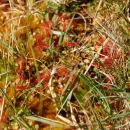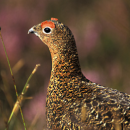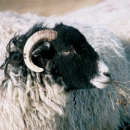NINE-YEAR LABOUR OF LOVE TO RESTORE PEAK MOORLAND

Peak District farmer and Moorland Association member Geoff Eyre has spent nine years restoring 425 acres of moorland from impenetrable bracken back to a more diverse heather-rich habitat, providing a boost for native wildlife and adding to its carbon capturing potential.
From a virtual desert, today the restored area is home to a wide variety of birds and animals including Brown Hare, Skylark, Meadow Pipit, Ring Ouzel, Kestrel, Barn Owl, Snipe, Lapwing, Curlew, Golden Plover, Red Grouse and Heron with various songbirds, bees, frogs and newts.
Geoff Eyre has been a farmer for 60 years, and has restored Derbyshire moorlands over the past 30 years, developing a variety of techniques to revegetate bare peat and restore moorland flora and fauna.
The work at Abney Moor began in 2013 with the removal of a huge area of dense bracken, some of it reaching six feet in height. The bracken was treated with herbicide to prevent any regrowth and subsequently burnt to ensure vigorous regrowth of target plants. Abney Moor had been owned by the same family since 1735 prior to Geoff’s ownership.
Bracken is an invasive species and generally provides good cover for foxes, which are significant predators of ground-nesting moorland birds. Its spores are carcinogenic and bracken is also known to be a habitat favoured by ticks, which can carry debilitating human diseases such as Lyme disease.
Once cleared, the next step was to seed the area with plants that are ideally suited to the conditions in the uplands, including Heather, Cottongrass, Tormentil, Bedstraw, Heath Rush, Wood Rush, Sheep’s Sorrel, Agrostis, Sweet Vernal, Wavy Hair-grass, and various berries and mosses.
The plants took very well and grew in abundance within two years of seeding.
Ongoing management was required to maintain the diversity rather than letting one plant dominate over all the others, thereby providing homes for a greater abundance of species.
Geoff Eyre says: “The Peak District moors have some bog, but only a tiny percentage, unlike those wetter moors further north, we have also wet areas on shallow peat and very dry areas on deep peat. Sphagnum moss is only growing in small pockets.
In order to keep the moorland in good condition and reduce the threat of wildfire, we carry out controlled burning in the winter months. This promotes the growth of Sphagnum Mosses and Heathers, providing good quality habitat for our indigenous Red Grouse and a wide range of birds that use the moors for breeding in the spring.
“I have been delighted by the results of the managed burn this year. The heather has flowered exceptionally well, attracting bees, and the growing plants lock up carbon from the atmosphere. The Meadow Pipits and Skylarks are now too numerous to count.”
Working with the School of Environmental Sciences at the University of Liverpool, Geoff Eyre sought to compare the advantages of using a cool burn to manage the vegetation, in comparison to cutting the area. Both of these techniques will reduce the threat of wildfire on moorland, an increasingly serious problem in recent years.
Rob Marrs, Emeritus Professor of Applied Plant Biology at the University of Liverpool, assessed the cool burn conducted in March 2021 and found that it removed just 10 to 15 per cent of the plant mass. The stalks are generally left behind and were covered in charcoal, potentially trapping carbon. In fact on examination the stalks were found to be made up of 50% carbon.
Geoff Eyre believes that the alternative, cutting the vegetation, does not produce the same results: “Where cutting is used as a moorland management tool, the vegetation is often left to rot, which can release methane, the worst of the greenhouse gases. By contrast, a quick, managed burn allows the plants to regenerate quickly, locking up more carbon in the process and the charcoal layer also means that carbon can’t breakdown and escape.”








